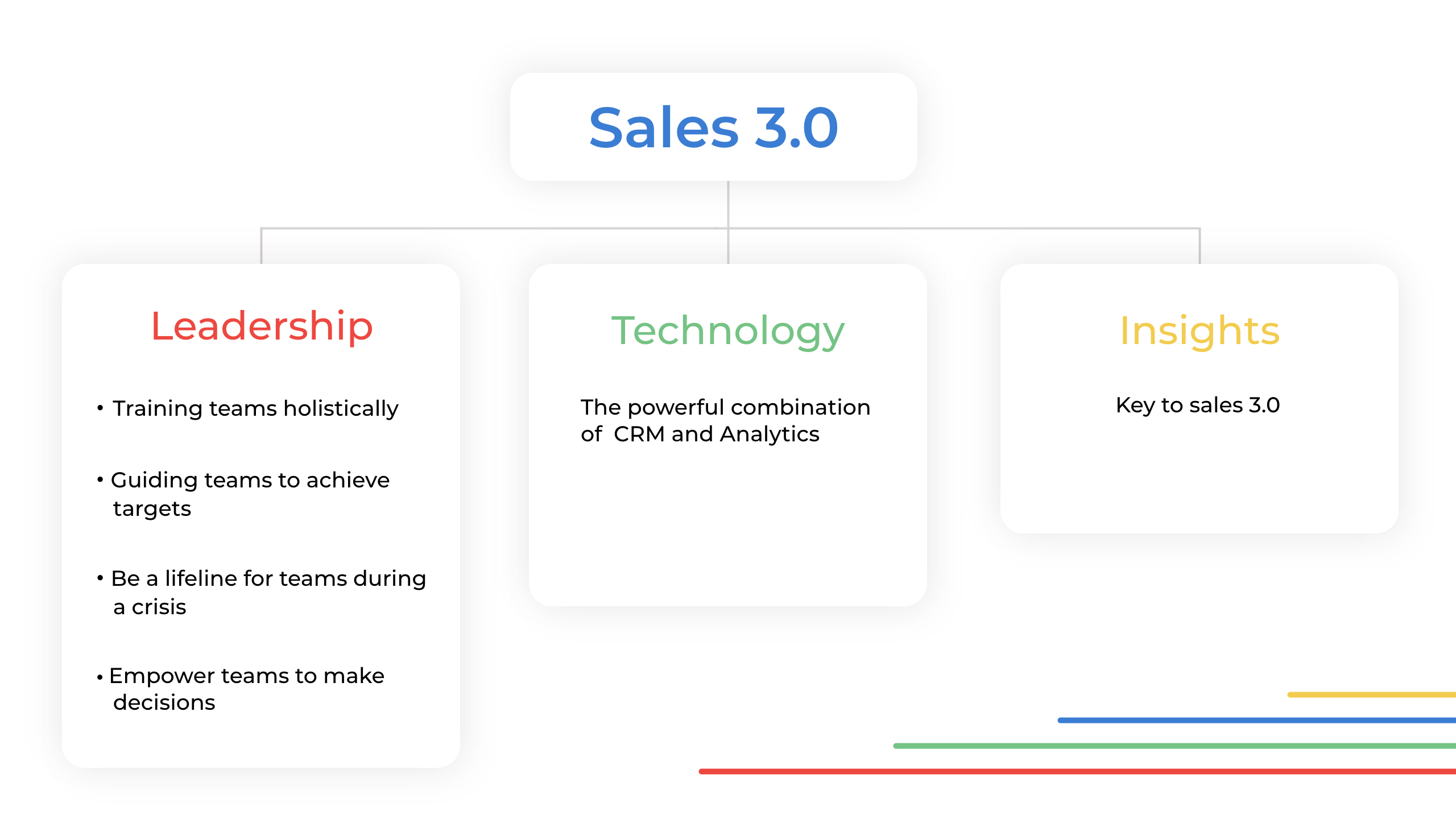Amidst chaotic business cycles, if there’s one thing that has quietly yet rapidly evolved and adapted itself in hyper-competitive business environments, it would have to be sales.

Sales 1.0 used to be all about the salespeople, and sales strategies were heavily dependent on their experiences. Today, it’s Sales 2.0, where technology augments sales. With sales tools and apps flooding markets, a large chunk of sales has gone online and digital.
So what will define Sales 3.0? We foresee a holistic approach to sales as the way forward. A perfect mix of leadership skills, backed by powerful technology and driven by insight got through a sales analytics software , will define Sales 3.0.

In this blog, we’ll use the powerful combination of Zoho CRM and Zoho Analytics to harness insights that can help salespeople build the desired leadership skills for Sales 3.0.
Training teams holistically
Sales numbers aren’t the sole indicator for evaluating your team’s performance. It’s also recommended that you assess your team across multiple sales metrics to build competencies on the various aspects of sales.
For this reason, it’s important to have a versatile performance assessment system that can flexibly accommodate metrics depending on your business needs.

This can be your go-to report for holistic training. The team is assessed on seven different sales metrics picked from five different modules in Zoho CRM. Using the simple drag and drop feature, you can add or remove the metrics on which you want your teams groomed.
During a downturn, businesses may focus more on receivables and less on sales. Using the powerful formula engine built into Zoho Analytics, you can assign weightage to the receivables metrics and sum it up to arrive at an overall score, to enable teams to focus on more business critical areas.
With this data, sales leaders can shift to multidimensional assessment of teams by evaluating and training them across multiple sales metrics that are important for the business at that point of time.
Guiding teams to achieve targets
Sales numbers are the end objective, and teams fervently work on ways to achieve those numbers. You and your team may unanimously choose a set of activities to produce results, but in many cases, they can be counter – productive. As sales leaders, are you able to guide your teams to achieve their targets?
Get started by analyzing the historic performance of your sales activities to find out which one has the highest conversion rate. This could be one of the many things you can ask your sales team to focus on.
This analysis holds good for regions, too. However, customers are different across geographies. By performing a similar analysis using a geo map for all your markets, you can better guide your regional teams. For example, on mouse hover, tasks have the highest conversion percentage (38%) in the US. If the team in the US can focus more on those tasks, it can probably yield better conversions.
This granular analysis of activities can help sales leaders answer the question of “what works where?” With that, they can guide their team towards achieving the target.
Be a lifeline for teams during a crisis
When sales stagnate or drop, it’s usually the sales team that’s held accountable. However, a sales team is not a stand alone system. It has to function with marketing, finance, support, and more. It’s important to have end-to-end insights to help your team during a crisis.

The powerful data blending feature in Zoho Analytics explains how the leads get converted into business. Data fetched from multiple ad platforms, like Facebook, Twitter, and LinkedIn, are on top of the funnel. The Deals and Won Deals from a CRM service detail out the conversions. The Invoices and Paid Invoices data are fetched from a finance application to better understand invoicing and receivables. You can further customize this report with data from more sources to perform cross-functional analytics for more insights.
With end-to-end insights, you can precisely identify stress points and give a definitive way forward during a crisis. Also, it builds accountability on the respective teams.
Empower teams to make decisions
Good insights are the key to Sales 3.0. They should be broken down, and easily consumed and digested for teams to trigger necessary actions. A few ways of enabling this is by shortening the learning curve and cutting down on the time to insights. The powerful dashboards in Zoho Analytics can be a great way of achieving these.

This dashboard has all the key metrics that any sales team would like to monitor on the top, in the form of widgets. You can add as many widgets as you want. This can effectively reduce the time to insights, as teams need not scramble around for these numbers.
Every business-critical metric, can be monitored and tracked in the form of reports. Depending on your business needs, you can add as many reports as you want. The high degree of flexibility and interactivity offered by these dashboards enables teams to perform ad hoc analysis for quicker decisions.
Summary
In hyper-competitive business environments, sales teams need to focus more on sales and less on trying to acquire data from multiple sources, and then analyze them for end-to-end insights.
A good CRM service, when combined with a powerful BI platform, can help sales leaders confidently step into Sales 3.0. The key to Sales 3.0 lies in acquiring the perfect mix of leadership skills, backed by powerful technology and driven by insights. Analytics is not the silver bullet to transform teams from Sales 2.0 to Sales 3.0, but is indeed an indispensable enabler in propelling this transformation.
Sign up now with our end-to-end business intelligence platform to prepare your teams for this transformation.
And then watch our webinar on A Holistic Approach to Sales using Analytics.
Comments